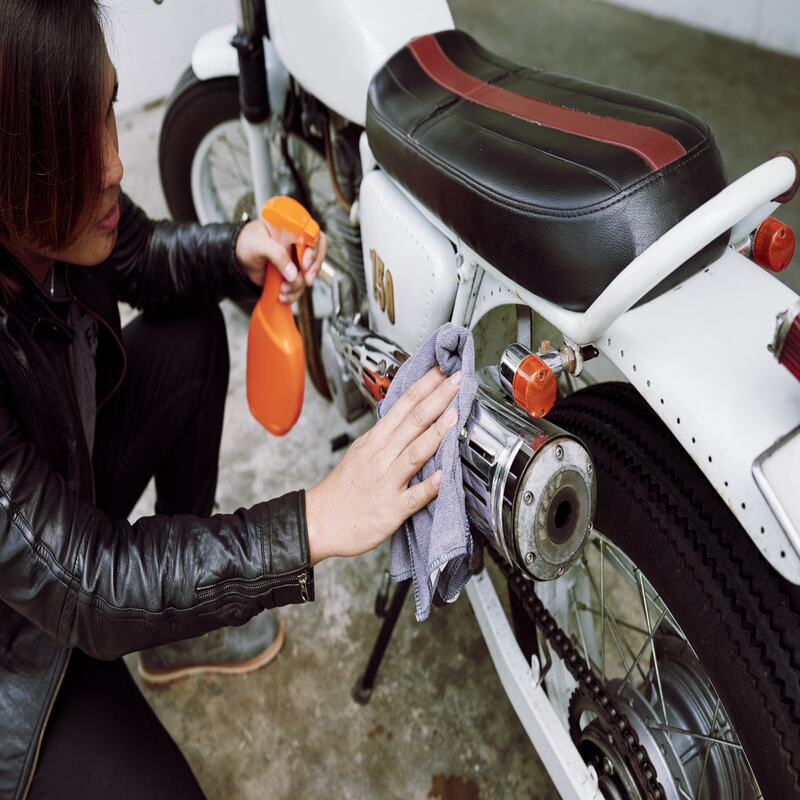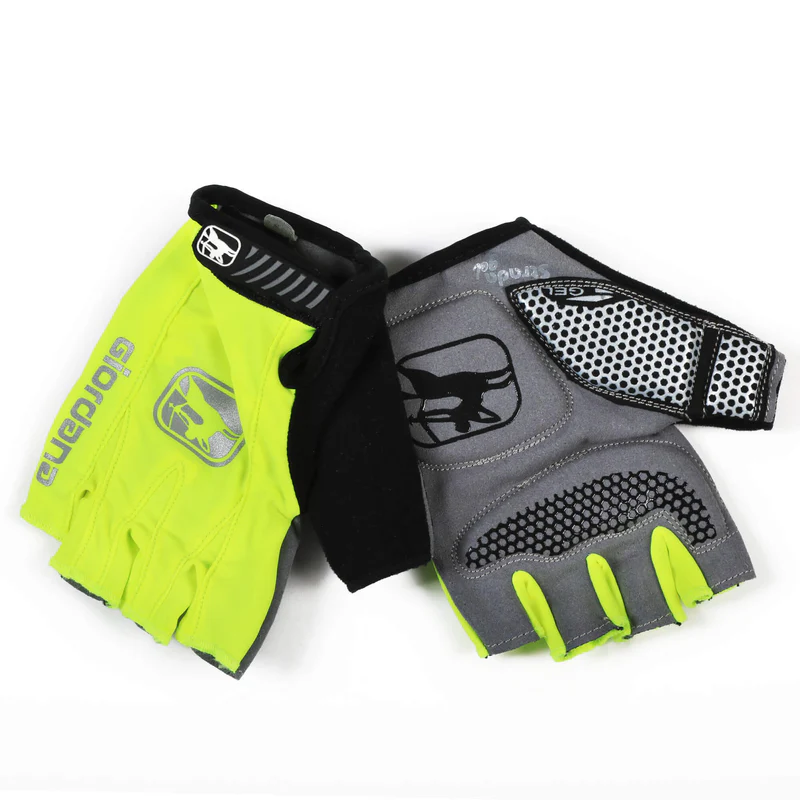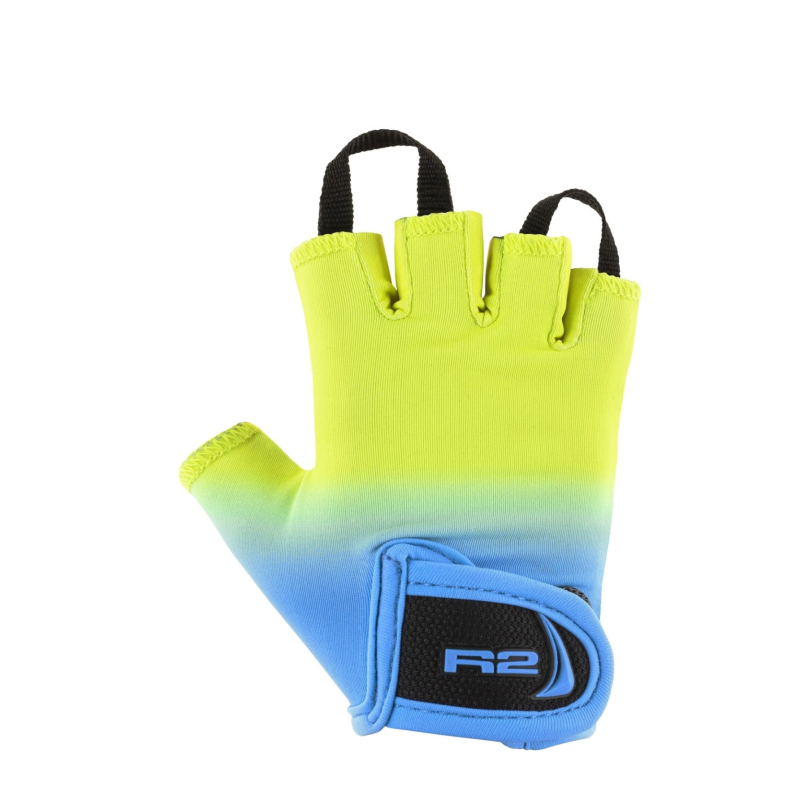Washing your motorcycle is an essential maintenance task that not only keeps it looking sharp but also helps extend its lifespan. Accumulated dirt, grime, and road salt can damage the paint, chrome, and vital components over time. Regular cleaning ensures your motorcycle remains in optimal condition, providing a safer and more enjoyable riding experience. This comprehensive guide covers every aspect of washing a motorcycle, from preparation to final touches. By understanding and following these steps, you can effectively clean and maintain your motorcycle. Therefore, let’s dive into the specifics of washing a motorcycle to ensure it stays in top form.
Preparing for the Wash
Proper preparation is crucial for an effective and safe motorcycle wash. Therefore, understanding the necessary initial steps can make the entire process smoother.
Selecting the Right Location
Choosing the right location is the first step in preparing to wash your motorcycle. Ideally, select a shaded area to prevent the cleaning products from drying too quickly, which can leave spots and streaks. Avoid washing your motorcycle in direct sunlight or on a hot surface. A driveway, garage, or any flat, shaded area works well. Ensuring good drainage is also important to avoid puddles around your workspace. Therefore, selecting the right location sets the stage for a successful wash.
Gathering Essential Supplies
Having all necessary supplies on hand simplifies the washing process. Essential items include a gentle motorcycle-specific cleaner, microfiber cloths, soft sponges, brushes, and buckets. Additionally, gather a hose with a spray nozzle, a chamois or drying towel, and chain lubricant. For chrome parts, you might need a specialized chrome cleaner and polish. Having a tool kit ready for minor adjustments is also beneficial. Therefore, gathering essential supplies ensures you’re prepared for a thorough cleaning session.
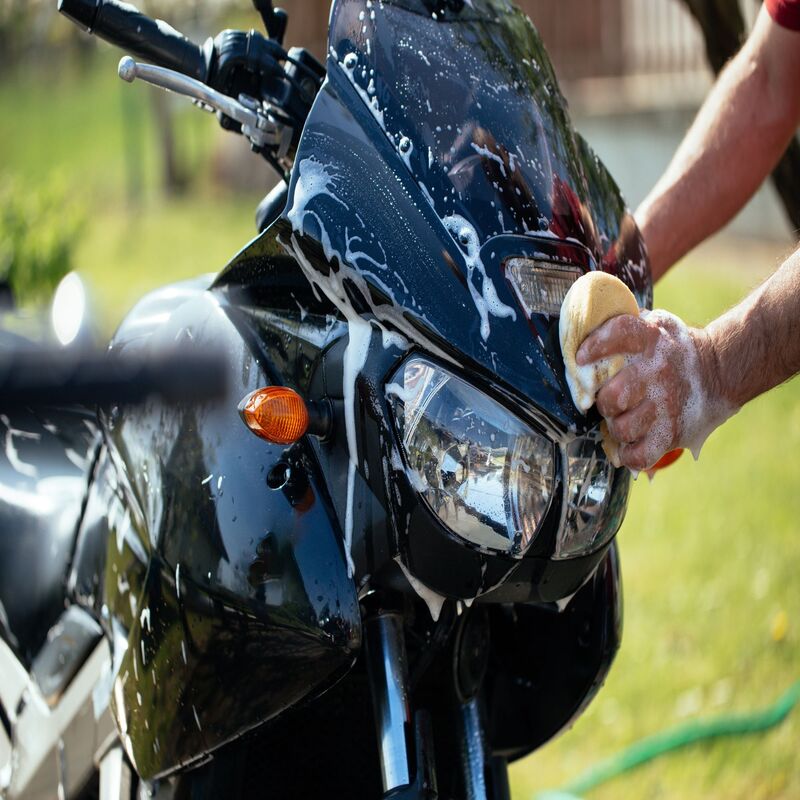
Initial Cleaning Steps
The initial steps focus on removing loose dirt and preparing the motorcycle for deeper cleaning. Therefore, starting with these steps makes the upcoming tasks more effective.
Rinsing Off Loose Dirt
Begin by rinsing your motorcycle with water to remove loose dirt and debris. Use a hose with a spray nozzle to direct the water flow, ensuring you reach all areas, including hard-to-reach spots like the undercarriage. Start from the top and work your way down to avoid pushing dirt into cleaned areas. This initial rinse helps prevent scratches during the scrubbing stage. Therefore, thoroughly rinsing off loose dirt is a crucial first step in the cleaning process.
Applying Pre-Wash Treatment
A pre-wash treatment helps loosen stubborn grime and bugs, making the main wash more effective. Use a motorcycle-specific pre-wash cleaner, spraying it onto the dirtiest parts of the bike, such as the front forks, wheel wells, and exhaust. Allow the cleaner to sit for a few minutes to break down the grime. Avoid letting it dry on the surface, as this can cause streaks. Therefore, applying a pre-wash treatment prepares your motorcycle for a more thorough cleaning.
Washing the Motorcycle
The main washing phase involves scrubbing and cleaning all parts of the motorcycle. Therefore, following a systematic approach ensures comprehensive cleanliness.
Cleaning the Bodywork
Use a bucket of warm, soapy water with a motorcycle-specific cleaner to wash the bodywork. Dip a soft sponge or microfiber cloth into the solution and gently scrub the surface. Focus on one section at a time, starting from the top and working your way down. Avoid using harsh brushes or abrasive materials that can scratch the paint. Rinse the sponge frequently to prevent dragging dirt across the surface. Therefore, cleaning the bodywork carefully preserves the paint and finish.
Washing the Wheels and Tires
Wheels and tires accumulate significant grime and require special attention. Use a wheel brush and a mild cleaner to scrub the wheels, reaching into the crevices and spokes. For the tires, use a stiffer brush to remove dirt and brake dust. Rinse thoroughly to ensure no cleaner residue remains, as it can affect braking performance. Consider applying a tire dressing to enhance shine and protect the rubber. Therefore, cleaning the wheels and tires effectively enhances both appearance and performance.
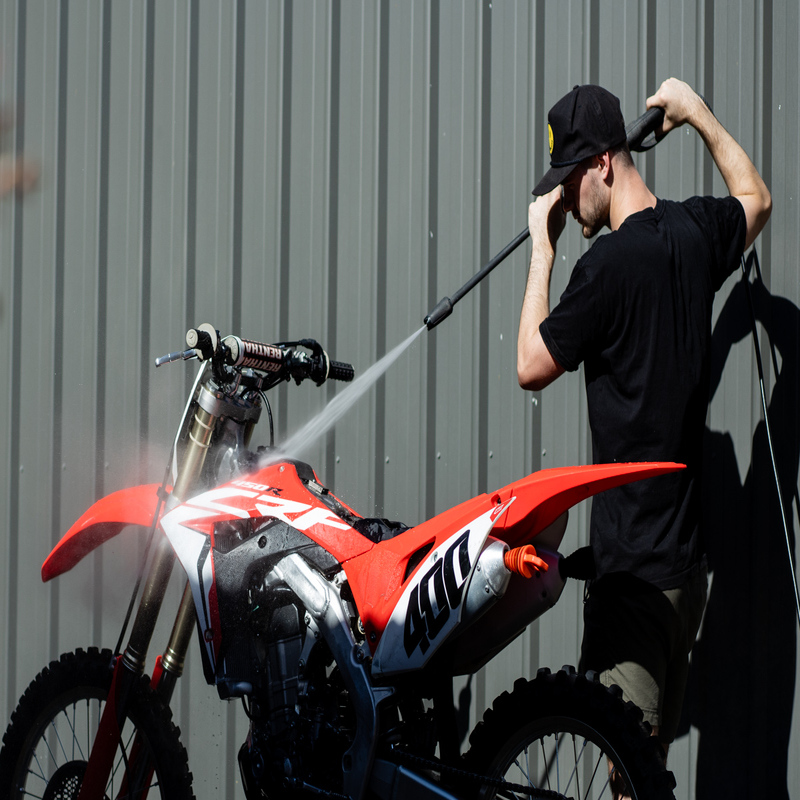
Final Rinse and Drying
Proper rinsing and drying are critical to prevent water spots and streaks. Therefore, understanding these steps ensures a pristine finish.
Final Rinse
After scrubbing and cleaning, give your motorcycle a final rinse to remove all soap and residue. Use a hose with a gentle spray to thoroughly rinse each section, ensuring no cleaner remains on the surface. Pay close attention to areas like the undercarriage, wheels, and other intricate parts. A thorough rinse prevents water spots and prepares the motorcycle for drying. Therefore, a meticulous final rinse is essential for a spotless finish.
Drying the Motorcycle
Drying your motorcycle properly prevents water spots and corrosion. Use a chamois or microfiber drying towel to blot and wipe down the surface gently. Start from the top and work your way down to prevent water from dripping onto dried areas. Use compressed air or a leaf blower to remove water from hard-to-reach spots and seams. Ensure all areas are completely dry, especially the chain and brake components. Therefore, thorough drying is critical for maintaining the motorcycle’s appearance and condition.
Additional Cleaning and Maintenance
Beyond the basic wash, additional cleaning and maintenance steps can enhance your motorcycle’s performance and longevity. Therefore, incorporating these tasks into your routine is beneficial.
Polishing Chrome and Metal Parts
Polishing chrome and metal parts adds shine and protects against rust and corrosion. Use a chrome polish and a soft cloth to gently buff the chrome parts, such as the exhaust, handlebars, and mirrors. Apply the polish in a circular motion, then wipe off with a clean cloth. For other metal parts, use a metal polish suitable for the specific material. Regular polishing maintains the luster and prevents tarnishing. Therefore, polishing chrome and metal parts enhances both aesthetics and durability.
Lubricating the Chain
After washing, it’s crucial to lubricate the chain to ensure smooth operation and prevent rust. Use a designated motorcycle chain lube, applying it generously to the chain while rotating the rear wheel. Allow the lubricant to penetrate for a few minutes, then wipe off the excess with a clean cloth. Lubricating the chain regularly reduces friction and wear, extending the chain’s lifespan. Therefore, chain lubrication is an essential maintenance step for optimal performance.
Special Considerations for Different Motorcycles
Different types of motorcycles may require specific cleaning techniques and considerations. Therefore, tailoring your approach to your bike’s type ensures the best results.
Cleaning Sport Bikes
Sport bikes often have sleek designs and intricate bodywork that require careful cleaning. Pay special attention to the fairings, using a soft sponge and mild cleaner to avoid damaging the paint. Use compressed air to remove water from tight spots, such as around the engine and frame. Cleaning the windshield and mirrors with a glass cleaner ensures clear visibility. Therefore, cleaning sport bikes involves meticulous attention to detail to maintain their appearance.
Cleaning Cruisers and Touring Bikes
Cruisers and touring bikes often have larger surfaces and more chrome parts. Focus on polishing and protecting these areas to maintain their shine. Use a soft brush to clean intricate parts like the engine fins and exhaust pipes. For leather seats and saddlebags, use a specialized leather cleaner and conditioner to prevent drying and cracking. Therefore, cleaning cruisers and touring bikes involves preserving both the metal and leather components.
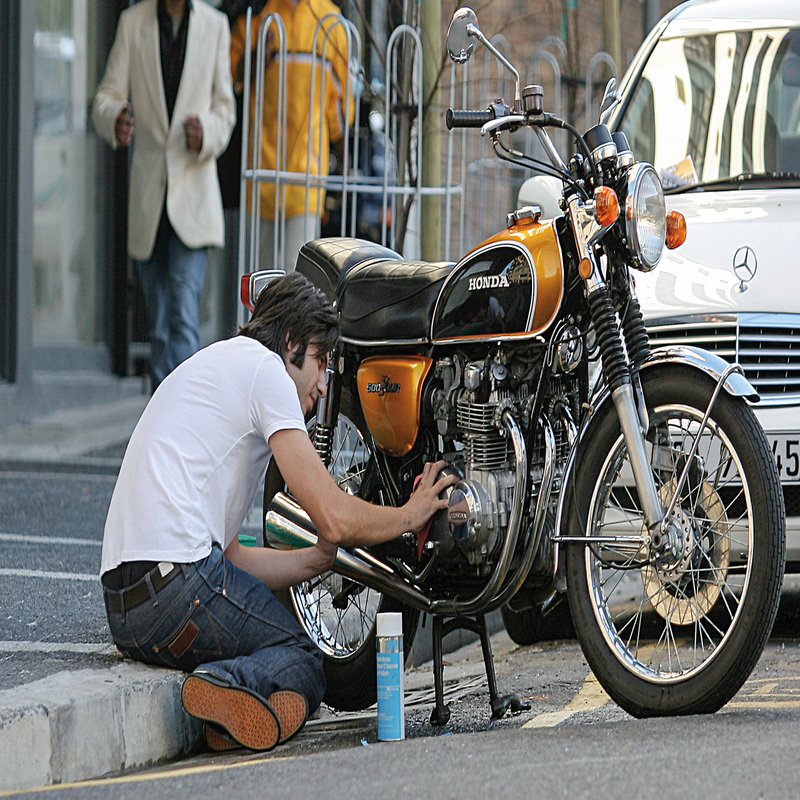
Troubleshooting Common Issues
Despite your best efforts, you may encounter common issues during the cleaning process. Therefore, understanding how to troubleshoot these problems can save time and effort.
Removing Stubborn Stains
Stubborn stains, such as tar, bugs, or bird droppings, can be challenging to remove. For tar, use a tar remover or a small amount of kerosene on a cloth, gently rubbing the affected area. For bugs and bird droppings, soak the area with warm, soapy water and let it sit for a few minutes before scrubbing. Avoid using sharp objects that can scratch the paint. Therefore, knowing how to remove stubborn stains ensures a spotless finish.
Handling Rust and Corrosion
Rust and corrosion can damage your motorcycle if left untreated. For minor rust spots, use a rust remover or a mixture of baking soda and water, scrubbing gently with a brush. For more severe corrosion, consider using a commercial rust converter or seeking professional help. Applying a protective wax or sealant after cleaning can prevent future rust issues. Therefore, addressing rust and corrosion promptly maintains your motorcycle’s integrity.
Conclusion
Washing your motorcycle is a crucial maintenance task that enhances both its appearance and longevity. Proper preparation, including selecting the right location and gathering essential supplies, sets the stage for an effective cleaning process. Initial steps, such as rinsing off loose dirt and applying a pre-wash treatment, prepare the motorcycle for thorough cleaning.
The main washing phase involves careful cleaning of the bodywork, wheels, and tires, followed by a meticulous final rinse and thorough drying. Additional steps, like polishing chrome parts and lubricating the chain, enhance performance and durability. Special considerations for different types of motorcycles ensure tailored care for sport bikes, cruisers, and touring bikes.
Troubleshooting common issues, such as removing stubborn stains and handling rust, helps maintain your motorcycle’s pristine condition. By following these steps and incorporating regular maintenance into your routine, you can keep your motorcycle looking sharp and running smoothly.
Therefore, armed with this comprehensive guide, you are well-prepared to wash and maintain your motorcycle effectively, ensuring it remains in optimal condition for your riding pleasure.
